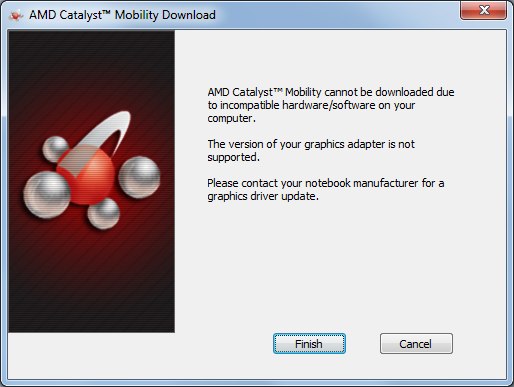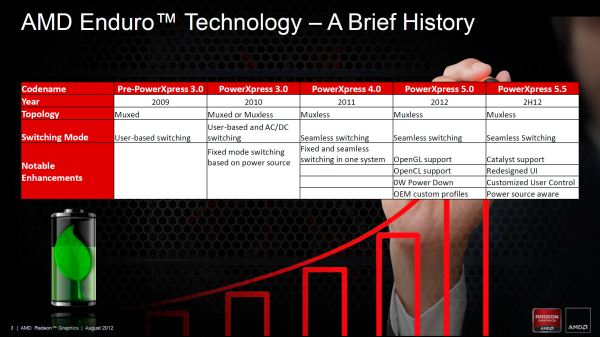AMD’s Enduro Switchable Graphics Levels Up
by Jarred Walton on September 6, 2012 3:00 AM ESTRecap: AMD’s PowerXpress, aka Dynamic Switchable Graphics, aka Enduro
Getting back to the switchable graphics, AMD has gone through a variety of names over the years. Here’s AMD’s summary slide, which I’ll discuss in detail:
Originally introduced as PowerXpress back in 2008, the first AMD switchable graphics solutions were like that found later in the ASUS UL80Vt and similar laptops: you had to flip a switch, and in the first iterations you would then need to reboot the laptop so that the BIOS could disable the discrete GPU and activate the integrated GPU. It was messy and a bit inconvenient, and NVIDIA’s early studies showed that many users ended up not using the feature—they would either run on dGPU all the time or on iGPU all the time. Both AMD and NVIDIA had a second series of switchable graphics designs where the need to reboot was removed; the first Alienware M11x could switch GPUs in about 10-15 seconds, and the same was true of HP’s first ENVY laptops. These were using PowerXpress 2.0 and 3.0, and for most people the switching side was adequate: you’d run on dGPU when plugged in and switch to iGPU when on battery power.
Last year, AMD took a step forward with their switchable graphics by introducing PowerXpress 4.0, which also renamed the technology to Dynamic Switchable Graphics (DSG for short). I got a chance to do a head-to-head of the technology using a Sony VAIO C laptop provided by NVIDIA. You know a company is confident that they’re going to win a technology comparison when they’ll actually give you a competitor’s product. In some cases, DSG was just as good as Optimus: you could launch a supported game and never realize all the extra stuff happening in the background; unfortunately, there were several titles where it wasn’t quite as convenient as we would have liked, and OpenGL support from DSG was completely missing.
Step forward to early 2012 and we got another update to PowerXpress 5.0 (note that PowerXpress is now only used internally by AMD and hasn’t been their marketing name since before PX4.0) along with a rechristening: Dynamic Switchable Graphics was out and Enduro was in. If nothing else, at least it makes my job easier as Enduro is much more concise. There's also the fact that the GPUs are no longer "switching", as the iGPU is always running; now the dGPU is simply supplementing the iGPU when needed. Along with the name change, AMD added OpenGL and OpenCL support to the mix, and with their Zero Core Technology (which is also part of their 7000 series desktop GPUs—a case of mobile design influencing desktops) the need to keep a small portion of the chip alive (aka BACO: Bus Active Chip Off) was removed. OEMs could also ship with custom profiles for applications, so for example Dell might want all of their extra utilities to default to running on the iGPU.

Hopefully this problem goes away next month!
Other than those changes, the UI and driver updates situation on early Enduro solutions remains largely the same as with DSG/PX4.0—and that’s what I initially received with the Clevo P170EM, with drivers from around March 2012. A quick check at AMD’s site also let me know that there weren’t any new drivers available, as the P170EM wasn’t currently supported by the latest Mobility Catalyst drivers.











200 Comments
View All Comments
blackmagnum - Thursday, September 6, 2012 - link
Finally for the people working/ gaming on an AMD graphics notebook. Hope this will be enough of a challenge for Optimus. Good news.hulawafu77 - Thursday, September 6, 2012 - link
Unfortunately this is not the case. The Enduro issue has actually driven more sales for Nvidia. AnandTech, please take a look at NBR forums. The number of decisions posted by NBR members saying, they have decided to pay an extra $300 for working Optimus far exceeds decision to buy 7970M equipped Clevo notebooks. This is after the member inquires on what is the best use of their money.On NBR it has been concluded for the most part. Even though on paper the 680M and the 7970M are equal, it makes far more sense to pay an extra $300 because 680M works. 7970M getting less performance on half the games compared to last gen's 580M?
I am really quite surprised and upset that gaming hardware community forget how expensive mobile parts are. 7970M users aren't upset because a $100 card isn't performing right, it's $200!!!! Our notebooks cost $1600 and more with a 7970M...
hulawafu77 - Thursday, September 6, 2012 - link
I would like to add, as a 7970M owner and been trying to get this problem resolved rather than going green...ANYONE WHO IS CONSIDERING A CLEVO P150EM and P170EM BETWEEN 680M AND 7970M, BUY THE 680M.
Seriously, don't buy 7970M. AMD has had 6 months to provide drivers since 7970M been released and we've received only one tweet. The 660M-680M are far better buy, and better value for your money than the 7970M right now. I would not expect AMD to fix this. It's a good chance, AMD may just chalk this up to, we'll fix it with 8xxx, F*** the 7970M users.
jeremyshaw - Thursday, September 6, 2012 - link
Yeah, I have a Vaio SA with a switchable HD6630m, I've already sworn off AMD mobile products. I don't care about whatever excuses they have, and apparently, neither does Sony. The Ivy Bridge successor to my laptop uses a Kepler GT 640m with nVidia Optimus. I got the SA to get away from general laptop build quality issues with my m11x R2, but if I had known I would be giving up Optimus for a far inferior setup, I would of just dealt with the other issues.extide - Thursday, September 6, 2012 - link
You don't have the described issue.Death666Angel - Saturday, September 8, 2012 - link
I don't understand what that has to do with this article though. Does your notebook or the other ones who complain already have Enduro as described in this article? Because the article makes it seem to me as if this is still in the future for a few months at least. So how can they have issues with something that doesn't exist, yet? :-)arcticjoe - Saturday, September 8, 2012 - link
I think you mis-understood something. Enduro is currently used in multiple AMD cards, and it has severe flaws. This article is about newer version of Enduro that is supposed to come out in the near future.Pablito Que - Thursday, December 13, 2012 - link
I bought an AVA bare bones P150EM With the Radeon 7970m.I wondered about updating the graphics driver the moment I got it, but I called AVA Direct first because I had heard there were problems with the drivers in doing so.
-- This goes for any Computer with the IVY bridge mother Bd--
whether P150EM or 170EM
This is what he told me:
"The drivers pre-installed on your computer are drivers made to interact at best performance with the intergraded graphics card on the mother board(HD graphics 4000). DO NO ATTEMPT TO DOWNLOAD AND INSTALL THE UPDATE ON AMD'S WEBSITE. THEY WILL NOT WORK PROPERLY. We try to make this clear to all who purchase the P150EM and 170, but they do not listen and think they've got it figured out. They go ahead and download the updates and the card fails! Everyone who calls us complaining about performance has tried to update the drivers when we warned them not to."
Since I have had my computer, I have had the drivers that it came with and with a 3720QM running ar 3.6Ghz. and 8 gigs of RAM at 1600Mhz, I'm getting Metro 2033 at 29.9 fps with 1920x1080 and all setting maxed out minus Anti-alaising. My card has just the stock drivers and it out performs the 680M on a number of major games and was over 50% cheaper than the 680M. There's NO logical argument anyone could make for choosing the 680M over the 7970m, especially driver support issues! If AMD's lame stock drivers already out perform Nvidia's best, then what will happen when the refined drivers are released? And when I say that the stock drivers out perform Nividia's, I mean in terms of frame rate from game to game- which is the ONLY thing that matters in the end.
Referrence: Notebookcheck.org
neoczar - Thursday, September 6, 2012 - link
I am one of hundreds that inhabit the NBR forums who have been unfortunate enough to get the P170EM platform with the 7970M. What began as a promising article (mentioning all the difficulties with the initial P170EM the writer reviewed) degenerated into reporting what the AMD guy promised would be implemented "soon". The question remains: What has AMD done for its customers who purchased the current flagship card?In case the writer hasn't noticed there has been a back-and-forth cyber-war of a sort going on with AMD over this for a few months now, with Enduro SEVERELY crippling performance in muxless designs like the P170EM. To say that the 7970M performs worse in WoW, SC2, Dota2 ..etc than a card 2 generations old is an understatement. Clevo/Sager began documenting the issue then were instructed by AMD to delete the threads on all relevant forums and we've been getting stonewalled since then. Clevo/Sager have reverted to "There is no issue" stance and AMD is simply quiet while doing damage control by all the smoke this article aims to spread.
I ask the writer: So after all walls of text, has the P170EM gotten any better with the 7970M since the last time you reviewed it? Play any game, ANY game, and let us know about the frame rates. I'm not sure I can post links here but there are quite a few that show you the magnitude of the problem, and AMD's utterly woeful driver team.
randinspace - Thursday, September 6, 2012 - link
Hmm... :\ Jarred, how optimistic are you that AMD is actually going to be able to deliver this time?As a total package I'm more comfortable with AMD's 7000 series GPUs than NVIDIA's 600 series, so I've got a LITTLE hope in this case, yet the way things have been going the past few years choosing a solution that relies solely upon them (AMD) is beginning to feel like not only a compromise (Phenom II vs Core 2), but a complete crap shoot (I had to buy a discrete GPU to solve a persistent issue I was having with a PC running an A8 and now I'm stuck with a dead socket that's outperformed by Intel's last 4 generations!).